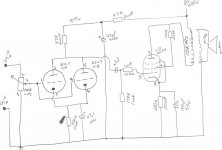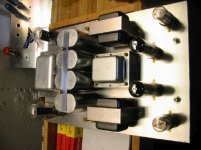jaymanaa said:Please be brutal.
Ok
Throw away that paralleled 6SL7 at the input and place a 6DJ8 SRPP
Other possibilties are 6DJ8 in cascode-with-nfb, a CCS-loaded 12AT7, all those things followed with a cathode follower, maybe DC coupled, to gain overdrive recovery. You have food for thoughts now
Aside from those kind of decisions, I would suggest a 470k resistor from the grid of the input stage to ground, in case the potentiometer looses contact (the amp will probably oscillate).
And also, from a 6CA7 you'll get 4W at those conditions. Use a 4800ohm load output transformer, it would be better. Or better, I suggest you remove the cathode bias (and implement fixed bias). With -43V on the grid and the 430V B+ you'll get almost 8W with 4800ohm output transformer.
I'm no expert yet but from what I've learned I would go for the parallelled 6sl7 (carefully selected tubes for balanced transconductance) instead of the suggested srpp
I follow Giaime where he suggests adding a 470k resistor + would swap the 150k output stage grid-ground resistor with 470k (didn't do the calculations but with a 0,1µ coupling cap and 150k resistor low-end will roll off early I think).
A lower output resistance opt than 10k (why so high?) and fixed bias sound very sensible to me too.
Lastly you might want to take a look at this method for triode-strapping pentodes; might regain some bass-firmness and overall attack: http://www.t-linespeakers.org/tubes/triode-trick.html. I'm currently waiting for the components to arrive to try this circuit; when going from pentode to triode-strapped pentode (in my case el84 se) the midrange becomes very lush and the sound loses overall attack. These traits apparently appeal to many but are overly coloured and soft for my taste - the linked circuit promises to restore some of the 'power'...
Good luck with your project,
Simon
I follow Giaime where he suggests adding a 470k resistor + would swap the 150k output stage grid-ground resistor with 470k (didn't do the calculations but with a 0,1µ coupling cap and 150k resistor low-end will roll off early I think).
A lower output resistance opt than 10k (why so high?) and fixed bias sound very sensible to me too.
Lastly you might want to take a look at this method for triode-strapping pentodes; might regain some bass-firmness and overall attack: http://www.t-linespeakers.org/tubes/triode-trick.html. I'm currently waiting for the components to arrive to try this circuit; when going from pentode to triode-strapped pentode (in my case el84 se) the midrange becomes very lush and the sound loses overall attack. These traits apparently appeal to many but are overly coloured and soft for my taste - the linked circuit promises to restore some of the 'power'...
Good luck with your project,
Simon
Thanks for the honest assesment an candid replys. That's what I'm looking for. The low PO and high OPT primary R are a result of going for least possible distortion with enough power for personal listening requirements. I'm not sure if 4 watts will be enough, and if it turns out that it is not, I will definately look into lower R Pri. BTW I took a look at your site. Very cool, and interesting stuff. I plan to return to it when I have more time to really look at everything. Thanks for your replys and suggestions, Jay
Oh BTW, the log pot will be replaced with a fixed resistor on completed amp.
Oh BTW, the log pot will be replaced with a fixed resistor on completed amp.
Klimon said:would swap the 150k output stage grid-ground resistor with 470k (didn't do the calculations but with a 0,1µ coupling cap and 150k resistor low-end will roll off early I think).
In that case, increase the capacitor, NOT the resistor. That resistor has a maximum value, if you put higher than what's specified in the datasheet the tube might go in runaway and destroy itself. In this case the maximum allowed is 700kohm, as the datasheet says, but an excessive value might cause trouble with new production tubes. My suggestion is to avoid increasing it over 220k.
Points well taken. This resistor value has come up as a topic with some other tuby friends of mine. This amp is my first, so I'm expecting (and looking forward to) some tweeking once I get it going. I have wondered about the .1 cap value quite a bit. I'm building the amp fairly large to accomodate some very generous iron and to also make changing passives easier. Here's a pic. Thanks and I'd love to hear more ideas, Jay
Attachments
Reducing the resistor's value is the impetus behind using a grid choke on an output stage as far as I know. If I remember correctly, it has to do with the voltage appearing across it when grid current flows.
The capacitor is cutting in at around 10Hz. Increasing it significantly may not be in the best interest of overload recovery. The capacitor charges when grid current flows. Many amps use values like this. YMMV, and as always, it's a matter of taste.
The capacitor is cutting in at around 10Hz. Increasing it significantly may not be in the best interest of overload recovery. The capacitor charges when grid current flows. Many amps use values like this. YMMV, and as always, it's a matter of taste.
Thanks for the good advice folks, she is singing beautifully. Much special thanks to Indm who has helped me allways, ever since I took up this madness. Also to tubes4ever who drew the original schematic and put it on a very well done web page to share with all. You have some very fresh and exciting ideas about tube audio IMHO. Just a BIG thanks to everyone, Jay
Other possibilties are 6DJ8 in cascode-with-nfb, a CCS-loaded 12AT7
The amp that I have been working on uses a CCS loaded 12AT7. I couldn't get enough gain with a resistor loaded triode, ANY triode, I tried a bunch, including the 6SL7 (but only one triode, not paralleled).
The rest of my amp is very similar to your design. I am using cathode bias, with a 560 ohm resistor and a 1500uF cap. It works fine, no overload issues. I have a 121K ohm metal film grid leak resistor. Coupling cap is .22uF. Stopper is 1K. Yes, add a resistor from the grid of the input tube to ground, value is not critical, but use a good quality part (I have 220K). A small stopper would be a good idea also (I have 150 ohm).
I have tried B+ voltages from 300 to 485 volts. I find my current power supply the best. It has a switch to select tube or solid state rectifier. I get 435 volts in tube mode and 470 volts in SS mode. I found that a BIG (100 uF) motor RUN cap across the output helps the sound. $14 from Ebay. I can run EL-34's, 6L6GC's KT-88's and 6550's in this amp with no changes. The 6L6GC's run right at the dissipation limits, so you can't use wimpy tubes.
I have been testing OPT's in this amp ever since I built it. I believe that 10K is far too high. I have tried everything from 2.5K to 10K in sizes from tiny to huge. As expected the distortion is higher as the impedance drops, and the MEASURED power is highest with a 5K transformer. I tried a Hammond 125CSE (wired for 10K), which made almost 4 watts. I also tried using my 5K Electra-Print transformers with a 16 ohm load which presented a 10K load to the tube. This provided just over 3 watts. Distortion at 1 watt was just under 1%. The 5K load (3 different transformer pairs, with one more pair on order) gave from 6 to 9 watts depending on the efficiency of the transformer. The little Edcor gave the most power with the Hammond 1628SE providing the least. The big Edcors have not arrived yet. Distortion at 1 watt ranged from 1.1 to 1.9% depending on the transformer. All measurements made in triode mode with no feedback, 470 volts B+ and JJ EL-34's.
I also experimented with a 3K ohm load (3 sets of transformers) and a 2.5 K load (2 sets). These clearly were too low of a load for the tube to be happy. Power was down (about 5 watts) and distortion was up (over 2%). However the good 3 K transformers (UBT-3 and Transcendar) provided the best sound with highly dynamic music on MY speakers. At first I was puzzled, then I found the "impedance VS frequency" plot for my Yamaha NS-10M speakers. These "8 ohm" speakers were over 20 ohms at 90 Hz and only came down to 8 ohms at two points in the audio range. If you have this information, you can make a better decision about your transformer choice. The 10 K transformers really sound anemic with these speakers, but may do OK for you if your speakers have dips in their impedance for frequencies that are common in your music.
I have added a switch to turn cathode feedback on or off. Some transformers (mainly the smaller ones) really like this, while it offers little or no improvement with some.
I have also added a switch to flip from triode to UL mode for use with transformers that have the tap. It offers more power with only a slight increase in distortion. Again the results vary by transformer.
I have put some of this info on my web site, with more to come. After I have had a chance to test all of the transformers, and several different tubes (6L6GC, KT-88, 6550 and EL-34's of various manufacture) the results will be posted.
Awesome website, I have visited often. I like different stuff. It just makes sense to me to try new ideas. My OPT's were wound at Heyboer and are closer to 9K. I was a little concerned about to little output power so I fudged a little on tubes4ever design. I'm using Heresy's right now and it seems like it will have enough power for most of my listening. The bass is very impressive. Haven't done any real testing yet, just listening. This is the first single ended amp I've ever heard, and I must say I like it. I'm allready thinking about DH. I'll be looking forward to following your test's and will report my findings also. Jay
Hi Jay,
As I mentioned elsewhere, I like the idea of a DH driver. Here's a couple of posts on my experiences http://www.diyaudio.com/forums/showthread.php?postid=924364#post924364 if you're interested. Forgive me the bit about falling out of my chair, I was excited at the time, y'know what I mean?
As I mentioned elsewhere, I like the idea of a DH driver. Here's a couple of posts on my experiences http://www.diyaudio.com/forums/showthread.php?postid=924364#post924364 if you're interested. Forgive me the bit about falling out of my chair, I was excited at the time, y'know what I mean?
- Status
- This old topic is closed. If you want to reopen this topic, contact a moderator using the "Report Post" button.
- Home
- Amplifiers
- Tubes / Valves
- Final schematic, I think?

